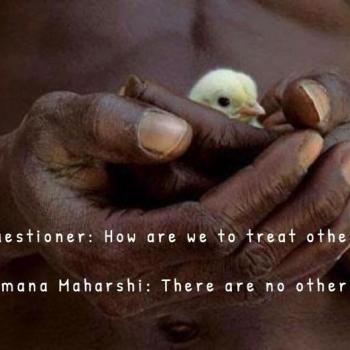Today, as in the past, the traditional Muslim looks upon all of science as "sacred," and studies this sacred science in a well-established threefold articulation. First, within the reach of all, is the Law, contained in essence in the Quran, elucidated by tradition and jurisprudence, and taught by the doctors; it covers every aspect of the social and religious life of the believer. Beyond that lies the Path dealing with the inner aspect of things, which governs the spiritual life of those who have been "elected" to follow it. This has given rise to the various Sufi brotherhoods, since it is actually a way of life built upon communication at a personal, nonsystematic level. Finally, there is the ineffable Truth itself, which lies at the heart of both these approaches.
According to a still-current simile, the Law is as the circumference of a circle, of which the Path is the radius, and the Truth the center. The Path and the Truth together form the esoteric aspect of Islam, to which Sufism is dedicated. At its core lies a metaphysical intuition, knowledge such as comes only to the right "mode in the knower." From this spring a science of the universe, a science of the soul, and the science of mathematics, each of them in essence a different metaphorical setting for that one science that the mind strives after, each of them a part of that gnosis that comprehends all things.
This may help explain why the mathematician, who was something of a displaced person in the West right up to the late Middle Ages, plays a central role in Islam from the very start. Two centuries after the establishment in the Near East of Christianity (in A.D. 313), the Christian-dominated West was still sunk deep in barbarism. Yet two centuries after Muhammad, the Islamic world under the Caliph Harun al-Rashid was already far more active culturally than the contemporaneous world of Charlemagne, even with the latter's earlier start. What reached the West from Islam at that time was little more than dark tales of incredible wealth and wondrous magic. In Islam itself, however, the mathematician's craft, having "found its home," was already able to satisfy the civilized man's desire for logical subtlety and for intellectual games, while philosophy itself reached out into the mysteries beyond reason.
This early stabilization of the theoretical outlook of Islam extended also to the type of man who embodied it. Whereas the role of intellectual leadership in the West devolved upon several different figures in turn -- the Benedictine monk, the scholastic doctor, the lay scientist - the central figure in Islam has remained almost unchanging. He is the hakim, who encompasses within himself some or all of the several aspects of the sage: scholar, medical healer, spiritual guide. If he happens to be a wise merchant too, that also falls into the picture, for he is traditionally an itinerant person. If his achievements in mathematics are extraordinary, he may become a figure like 'Umar Khayyam. It is clear, moreover, that such a man, be his name even Avicenna, will never be able to develop each of his several attainments in the same fashion as the single-faceted specialist may. Such specialists do exist in Islam, but they remain mostly secondary figures. The sage does not let himself be drawn into the specialist's single-level "mode of knowing," for then he would forfeit the higher knowledge. Intellectual achievement is thus, in a sense, always patterned upon the model of the unattainable complete, that "total thing" that is not found in the Greek tradition. Ptolemy's Syntaxis becomes in the Muslim world the Almagest or Opus Maximum even as Aristotle is purely and simply al-failasuf (the philosopher).
The title of Avicenna's great treatise, Kitab al-Shifa, which rivals in scope the Aristotelian corpus, means The Book of Healing. As the title implies, the work contains the knowledge needed to cure the soul of the disease of ignorance. It is all that is needed for man to understand; it is also as much as any man need know. Newton's work Principia has an obviously far different ring: it means a foundation, essentially, a "beginning" rather than a knowledge that is complete and sufficient for man's intellectual needs as the titles of so many medieval Islamic texts imply.
Islam came into the world at the beginning of the seventh century A.D., its initial date (the journey of the Prophet from Mecca to Medina) being 622 A.D.; it had spread over all of the Middle East, North Africa, and Spain by the end of that same century. Just as the Islamic religion is one of the "middle way," so too did its territory come to occupy -- in fact, it still occupies -- the "middle belt" of the globe, from the Atlantic to the Pacific. In this region, the home of many earlier civilizations, Islam came into contact with a number of sciences which it absorbed, to the extent that these sciences were compatible with its own spirit and were able to provide nourishment for its own characteristic cultural life.




